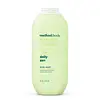What's inside
What's inside
 Key Ingredients
Key Ingredients

No key ingredients
 Benefits
Benefits

No benefits
 Concerns
Concerns

 Ingredients Side-by-side
Ingredients Side-by-side

Water
Skin ConditioningSodium Lauryl Sulfate
CleansingCocamidopropyl Betaine
CleansingParfum
MaskingCoco-Glucoside
CleansingGlyceryl Oleate
EmollientGlyceryl Stearate
EmollientGlycol Distearate
EmollientAmmonium Chloride
BufferingCitric Acid
BufferingGlycerin
HumectantLauryl Lactate
EmollientMethyl Glucose Caprate/Caprylate/Oleate
EmollientPolyglyceryl-3 Laurate
EmulsifyingPropanediol
SolventCamellia Sinensis Leaf Extract
AntimicrobialCucumis Sativus Fruit Extract
EmollientFucus Vesiculosus Extract
EmollientEthylhexylglycerin
Skin ConditioningMethylchloroisothiazolinone
PreservativeMethylisothiazolinone
PreservativePhenoxyethanol
PreservativeWater, Sodium Lauryl Sulfate, Cocamidopropyl Betaine, Parfum, Coco-Glucoside, Glyceryl Oleate, Glyceryl Stearate, Glycol Distearate, Ammonium Chloride, Citric Acid, Glycerin, Lauryl Lactate, Methyl Glucose Caprate/Caprylate/Oleate, Polyglyceryl-3 Laurate, Propanediol, Camellia Sinensis Leaf Extract, Cucumis Sativus Fruit Extract, Fucus Vesiculosus Extract, Ethylhexylglycerin, Methylchloroisothiazolinone, Methylisothiazolinone, Phenoxyethanol
Zinc Pyrithione 1%
AntiseborrhoeicWater
Skin ConditioningSodium Laureth Sulfate
CleansingCocamide Mea
EmulsifyingSodium Xylenesulfonate
Zinc Carbonate
Glycol Distearate
EmollientSodium Lauryl Sulfate
CleansingCocamidopropyl Betaine
CleansingDimethicone
EmollientSodium Chloride
MaskingParfum
MaskingGuar Hydroxypropyltrimonium Chloride
Skin ConditioningSodium Benzoate
MaskingStearyl Alcohol
EmollientMagnesium Carbonate Hydroxide
BufferingCetyl Alcohol
EmollientPolyquaternium-76
Camphor
MaskingEucalyptol
PerfumingMethylchloroisothiazolinone
PreservativeMethylisothiazolinone
PreservativeMenthol
MaskingBlue 1 Lake
Cosmetic ColorantCI 17200
Cosmetic ColorantZinc Pyrithione 1%, Water, Sodium Laureth Sulfate, Cocamide Mea, Sodium Xylenesulfonate, Zinc Carbonate, Glycol Distearate, Sodium Lauryl Sulfate, Cocamidopropyl Betaine, Dimethicone, Sodium Chloride, Parfum, Guar Hydroxypropyltrimonium Chloride, Sodium Benzoate, Stearyl Alcohol, Magnesium Carbonate Hydroxide, Cetyl Alcohol, Polyquaternium-76, Camphor, Eucalyptol, Methylchloroisothiazolinone, Methylisothiazolinone, Menthol, Blue 1 Lake, CI 17200
 Reviews
Reviews

Ingredients Explained
These ingredients are found in both products.
Ingredients higher up in an ingredient list are typically present in a larger amount.
Cocamidopropyl Betaine is a fatty acid created by mixing similar compounds in coconut oil and dimethylaminopropylamine, a compound with two amino groups.
This ingredient is a surfactant and cleanser. It helps gather the dirt, pollutants, and other impurities in your skin to be washed away. It also helps thicken a product and make the texture more creamy.
Being created from coconut oil means Cocamidopropyl Betaine is hydrating for the skin.
While Cocamidopropyl Betaine was believed to be an allergen, a study from 2012 disproved this. It found two compounds in unpure Cocamidopropyl Betaine to be the irritants: aminoamide and 3-dimethylaminopropylamine. High-grade and pure Cocamidopropyl Betaine did not induce allergic reactions during this study.
Learn more about Cocamidopropyl BetaineGlycol Distearate serves as a pearlizing or opacifying agent in cosmetic products.
It's often included in cleansers and haircare products to give them a lustrous or shimmering appearance.
It is derived from stearic acid, a natural fatty acid commonly found in vegetable oils and animal fats.
Glycol Distearate isn't fungal acne safe.
Learn more about Glycol DistearateMCI is a preservative and known skin-irritant. It has anti-bacteria anti-fungal properties.
Studies spanning several decades have shown this ingredient to cause skin irritation and allergies.
MCI is commonly combined with methylisothiazolinone (MI). Other names for this mixture include Kathon CG and Euxyl K 100.
The use of this ingredient varies around the world:
Learn more about MethylchloroisothiazolinoneMI is a preservative and known skin irritant. In the past, MI was used for its ability to prevent bacteria, yeast, and fungi growth in low doses.
Nowadays, you'll most likely see MI combined with Methylchloroisothiazolinone (MCI). Trade names for this combination include Kathon CG or Euxyl K 100.
Since then, numerous studies have shown this ingredient to cause contact dermatitis, or skin irritation.
The use of this ingredient varies around the world:
Learn more about MethylisothiazolinoneParfum is a catch-all term for an ingredient or more that is used to give a scent to products.
Also called "fragrance", this ingredient can be a blend of hundreds of chemicals or plant oils. This means every product with "fragrance" or "parfum" in the ingredients list is a different mixture.
For instance, Habanolide is a proprietary trade name for a specific aroma chemical. When used as a fragrance ingredient in cosmetics, most aroma chemicals fall under the broad labeling category of “FRAGRANCE” or “PARFUM” according to EU and US regulations.
The term 'parfum' or 'fragrance' is not regulated in many countries. In many cases, it is up to the brand to define this term.
For instance, many brands choose to label themselves as "fragrance-free" because they are not using synthetic fragrances. However, their products may still contain ingredients such as essential oils that are considered a fragrance by INCI standards.
One example is Calendula flower extract. Calendula is an essential oil that still imparts a scent or 'fragrance'.
Depending on the blend, the ingredients in the mixture can cause allergies and sensitivities on the skin. Some ingredients that are known EU allergens include linalool and citronellol.
Parfum can also be used to mask or cover an unpleasant scent.
The bottom line is: not all fragrances/parfum/ingredients are created equally. If you are worried about fragrances, we recommend taking a closer look at an ingredient. And of course, we always recommend speaking with a professional.
Learn more about ParfumSodium Lauryl Sulfate (SLS) is a sulfate with surfactant properties.
The surfactant property make it a great foam creator and cleansing agent. Surfactants help bind ingredients that normally do not mix.
Some studies have shown skin irritation due to prolonged SLS use.
Sodium Laureth Sulfate (SLES) is a milder version of SLS.
Learn more about Sodium Lauryl SulfateWater. It's the most common cosmetic ingredient of all. You'll usually see it at the top of ingredient lists, meaning that it makes up the largest part of the product.
So why is it so popular? Water most often acts as a solvent - this means that it helps dissolve other ingredients into the formulation.
You'll also recognize water as that liquid we all need to stay alive. If you see this, drink a glass of water. Stay hydrated!
Learn more about Water